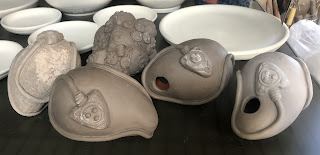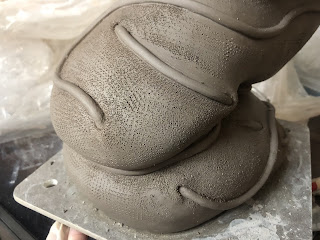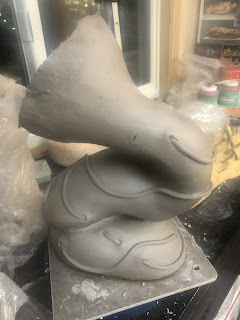cw: cancer
 |
| studio assistant (getting in the way) |
Taxol vs Adriamycin/Cytoxan
This week I finished my 3rd infusion of Taxol. The side effects of the Taxol continue to be much milder than the side effects of the A/C infusions. After the first round I had some problems with my hand which we thought were neuropathy. After I saw my oncologist, she indicated that it might not have been neuropathy from the Taxol. but might have been "hand and foot disorder" as a leftover reaction to the A/C.
 |
| peeling skin from hand and foot disorder (or neuropathy) |
The hand problems are getting better, which doesn't clarify what the cause was. My fingertips had been sore and starting to get dry and brittle during the A/C, but the pain and heat in the fingers started up in between the last A/C infusion and the first Taxol. During each of the Taxol infusions I've held on to bags of ice, which is supposed to keep the chemo from damaging the neurons in the fingers.
I've also been putting Arnicare cream or Aquaphor on my hands several times a day. The tips of my fingers a quite a bit better, but it seems I have to be much more diligent about keeping them moisturized than usual. Usually when I'm teaching in the clay studio in winter, my hands will get pretty dry from being outside and from being in and out of the water all day. But I've never before had the tips crack as much as they have this month. I don't remember the skin literally peeling like this, like after a sunburn. Lucikly, the pain and heat only lasted about a week.
 |
| Darter tolerates me in small doses; she was curious about my bald head |
The nausea is the best thing, in that it has mostly gone away. I was feeling so good last week that I put away my nausea medicine (meaning I took it off of my desktop medicine stash and put it in the cupboard). This Friday I had to get it out again, but just once, which is still an improvement over A/C.
The quantifiably good news this week was that my anemia is better. My hemoglobin and related numbers had been steadily dropping since I started chemo, but this week they finally moved up. I'm still anemic, but not as bad as last week. The increased hemoglobin numbers also mean that I'm less likely to need an intervention in the form of blood or blood products, which is what I was a bit worried about last week.
I don't know if anything I did helped with the anemia. I asked the doctor what I should do and she said there wasn't much I could do, but I made some adjustments in my diet anyway. We replaced our broken blender a few weeks back so that I could make smoothies when I wasn't feeling like eating. So now almost every morning I'm having a smoothie with a whole bunch of spinach and some wheat germ, along with whatever fruit we've got. I also tried to eat more protein in stew or soup or other meals over the past week.
 |
| Buddy can be a snuggly guy, until he bites (surprise!) |
My oncologist had indicated that the anemia shouldn't be as bad on Taxol. Either way, time passing or my diet adjustments made a difference and that feels good. I'd been feeling the effects of the anemia when I go for a walk. I get winded more easily and have had to take breaks or even call for Sean to pick me up. Around the time of the last A/C or first Taxol, I had a bunch of conversations about all the symptoms that were worrying me, including being out of breath. It made me feel better to know that the anemia was the reason I was out of breath. It made it less scary, really.
 |
| third taxol |
Also that week, after 8 or 9 weeks of chemo, I finally got a specific number for where I should keep my heart rate. When I first started seeing doctors about my cancer treatment, both in Seattle and in Yakima, I asked about excercise and how much I could continue to do. Both oncologists said I shouldn't work out too hard or bring my heart rate up too high, but were a bit vague about what counted as too high. I got the impression in Seattle that I shouldn't take spin class, but that leaves quite a bit of leeway between going for a walk and doing some kind of high intensity exercise.
As I've continued to do chemo, my energy has waned a bit, but I've still been unsure what is allowed or reasonable. Last week the nurse navigator told me I shouldn't let my heart rate get above 140. It has been nice to have a specific number, especially as I now can get my heart rate above 140 just by walking down the street or doing yoga at home.
 |
| All the cats like to come check out what I'm doing in the clay studio, especially right before dinner time |
Last weekend my daughter and I walked to the downtown library. We'd done this the weekend before, too, and its a bit shorter walk than the walk to school which we do most weekday mornings. Last weekend, armed with the 140 number, we made it less than 2 blocks before I needed to take a break. On the whole walk, we needed to stop and let me breathe maybe 5 or 6 times. My husband ended up picking us up at the library because I wasn't sure I could handle walking home (or it might take forever).
This was the worst I had felt just walking, though I'm pretty sure my heart rate would have gotten higher the week before (when I forgot my watch at home). This week I hadn't walked as much because the schools were on midwinter break, it had been cold, and I had to go to Seattle on Thursday. Today I went for a nice long, slow walk to check out a new (to us) little free library and I only had to slow down twice to let my heart rate get below 140.
 |
| a sculpture I've been working on in the past weeks |
Savi Scout Fail
The trip to Seattle this week was a bit ridiculous. In November, when I had my biopsy in Yakima, the people at Ohana put markers into my tumor and into the lymph node that they biopsied. These markers were meant to identify the location where the biopsy was taken. If the biopsy showed no cancer, these markers could be seen in future mammograms and show that these anomolies had already been checked. If the biopsy showed cancer the markers could help identify what needed to come out, at least I thought that was the plan.
For reasons I only partially understand, the Seattle Cancer Care Alliance (SCCA, where I plan to have my surgery), wanted to put in a different type of marker, called a Savi Scout, into my lymph node. They called me a little over a week ago and scheduled the appointment for this past Thursday, then they called again (four times) that day and wanted me to come in the very next day as there had been a cancellation. We determined that skipping chemo for this procedure didn't make sense, so I waited until this week.
 |
| after I started adding texture on the bottom of the sulpture, I broke my sprig |
It seems like this procedure is usually done before chemo begins, or very early in the chemo process. It sounds like it is also sometimes done shortly before surgery, but I think that's for folks who aren't doing neoadjuvant chemotherapy (before surgery chemo). I'm not sure why SCCA didn't have this Savi Scout put in in December or even January, though I suppose it might have been a miscommunication or a difference between how things are done in Yakima vs Seattle.
Regardless, we went to SCCA on Thursday this week to have the Savi Scout put into my lymph node. My oncologist had already indicated that she couldn't detect any swelling in my lymph node any more. Both the lymph node and the tumor in my breast appear to have responded positively to the chemotherapy treatment. I asked my oncologist last week if SCCA would be able to put in the Savi Scout if she couldn't detect the involved lymph node anymore. She seemed to think it would be fine.
 |
| once I broke the sprig, I had to figure out what to do with the bottom section |
When we got to SCCA, they had a doctor come in to use the ultrasound to find the old marker in my lymph node. This first doctor seemed a bit unsure of herself and didn't feel confident that she had found the marker. So she brought in another doctor. I think he was an attending, but I'm not totally sure of the difference between doctor ranks. This doctor seemed very confident and happy to help. So he looked for the marker with the ultrasound machine. He agreed with the first doctor that the thing that might be the marker wasn't clearly the marker and that together they didn't have confidence in identifying the right node. So they decided to talk to my surgeon.
My surgeon was out for the week, so they came back with a third doctor, this woman must have been some third level doctor as her confidence sort of glowed out of her. She took over the ultrasound, looked a bit and agreed with them. All three doctors asked me if I could help them by remembering where the mark was from the bioposy. They couldn't find a scar from the biopsy because the procedure was in November and tiny needle marks heal in 3 months.
 |
| I ended up mixing up the sprigged texture on the bottom section |
The upshot was that they simply couldn't do the procedure because there was no visual evidence of cancer in any of the lypmh nodes and no sign of the original marker. Three different people squeezed goo on my armpit and searched with the ultrasound wand thing. I got to see my arm muscles and lymph nodes on the screen and I agree that nothing looked like anything. I got to hear the same information from an increasingly senior and more confident doctor, but the result was the same. They didn't put in a Savi Scout.
I wonder what this particular bill will look like.
Though driving to Seattle for basically nothing might not be my first choice activity, the "problem" that caused the trip to be in vain is, ultimately, that I don't have any evidence of cancer in my lymph nodes (and also that my body seems to have absorbed or hidden the marker thing). So I can't be too upset about that part. I'm just over halfway through my chemo treatment and clearly the cancer is responding the way we want it to. My daughter suggested that my immune system is so strong it consumed the marker.
 |
| I had planned to use the port-a-cath in this sculpture as well, but chose something easier once I got started |
All three SCCA doctors assured me that not getting the Savi Scout wouldn't be a big deal. If I understand correctly, they will still take out some lymph nodes during the surgery. They'll do a procedure to identify the "sentinel node(s)." I believe this amounts to putting some dye stuff in the tumor and tracking where the dye drains to. The lymph nodes that the breast area drains to first are the sentinel nodes. We've got a bunch of lymph nodes in our armpit areas and this procedure helps the doctors find out which nodes are mostly likely to have cancer in them. Then they can remove just the lymph node(s) that are likely to be a problem and not the rest.
Back in the day, they used to take out a whole bunch of lymph nodes which could lead to lymphedema or swelling in the arm. By removing just a few, they can reduce that risk of swelling. The Savi Scout would have allowed them to take out the sentinel nodes and the previously biopsied node, but the previously biopsied node might be (probably is?) also a sentinel node so it may come out regardless.
 |
| building without a plan, and adding repetitive textures, feels comforting in a way that building sculpture that is trying to communicate something about the feeling of cancer is not |
As I understood it at the start of this whole process, the neoadjuvant chemotherapy had three main goals. First, and most important, was the goal of eliminating cancer in the rest of my body. Scans of my bones and body didn't reveal any evidence of cancer anywhere else in my body, but there was still the risk that there was a little bit of it somewhere that could grow in that new location, causing the cancer to spread.
The second goal was to reduce the size of the cancer in the lymph node, possibilty eliminating it. The third goal was to reduce the size of the tumor itself. As I understood it in December, the doctors thought they could do a lumpectomy (cut out the lump rather than the whole breast) even if the tumor didn't shrink and the tumor was unlikely to go away with just chemo. I think I thought that the lymph node might get smaller and might even go away.
 |
| I did want the form of this sculpture to suggest hiding or curling up on onesself for comfort |
As it turns out, the lump is smaller and the lymph node appears to have no cancer. I have to assume that means good things for any bits of cancer that might have been left in the rest of my body. All of this is clearly good news. I can't tell if it is better than expected or about what we expected.
The good response so far does make me wonder if I need the full 20 weeks of chemo. It has always seemed like a long time. At this point it feels doable, but it still feels like I have a long way to go. The doctors assured me that even if my tumor is gone after surgery, I still need radiation, and I understand that my treatment regimen has been tested and found to be the most effective at preventing recurrence (the cancer coming back), but at the same time, it feels like a lot.
 |
| the head section of the sculpture rests on the body and is only visible from certain angles |
As for the Savi Scout procedure, apparently they've only been using it to mark the involved lumph node for about a year. Had I been doing this process a year ago, I wouldn't have had the Savi Scout anyway. On the other hand, had we caught the cancer a year ago (like, had I started mammograms at 40) I'm thinking that the whole process would have been shorter and less unpleasant. PSA: Ladies, get your mammograms!




































